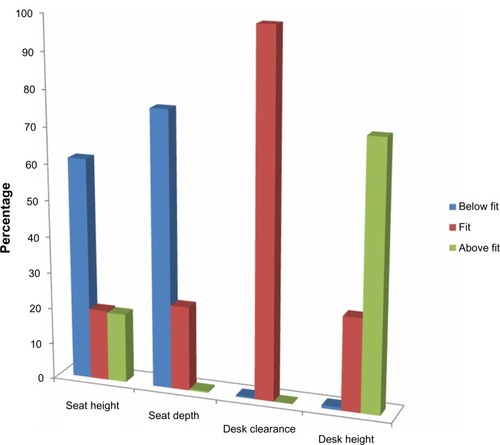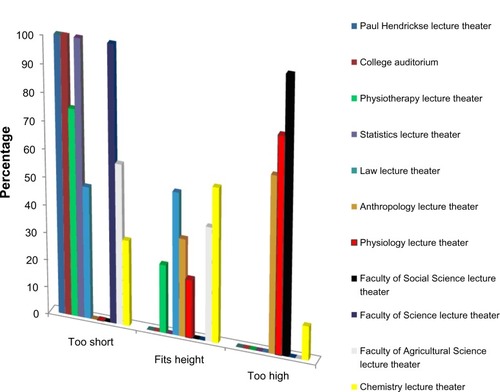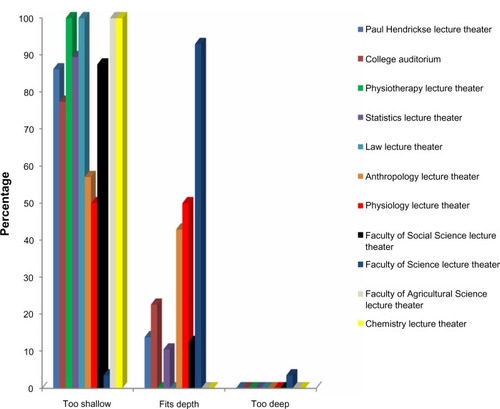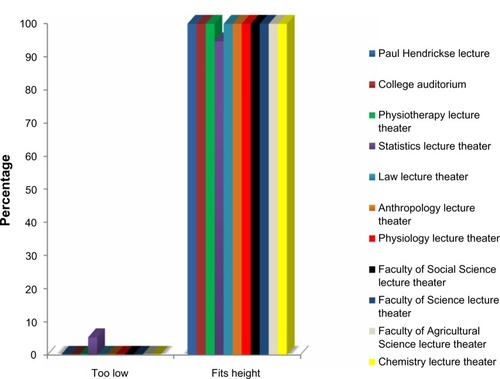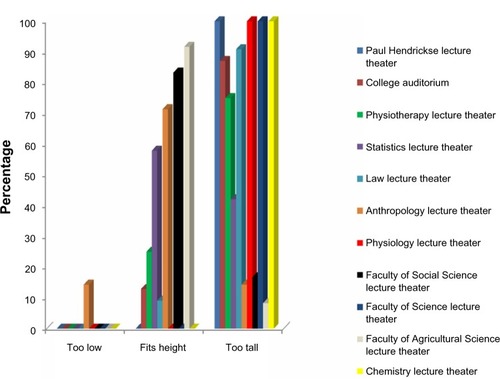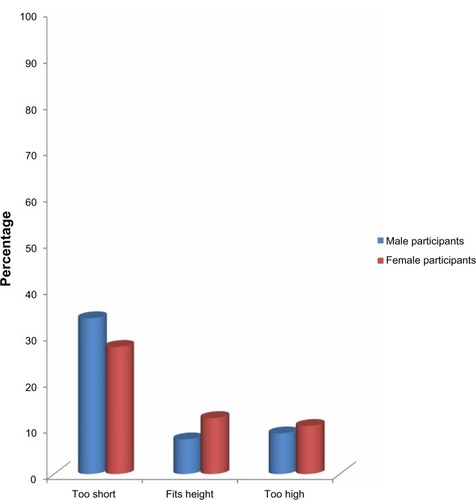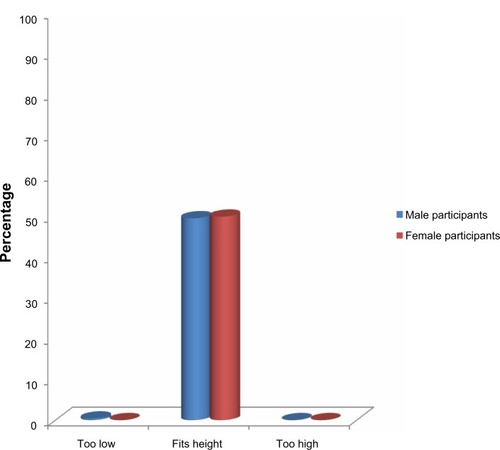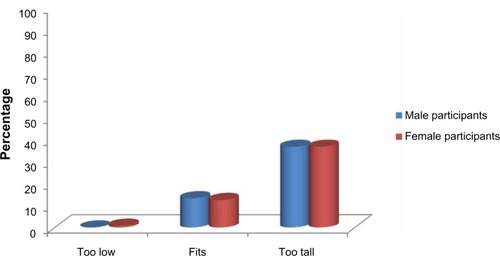 ?Mathematical formulae have been encoded as MathML and are displayed in this HTML version using MathJax in order to improve their display. Uncheck the box to turn MathJax off. This feature requires Javascript. Click on a formula to zoom.
?Mathematical formulae have been encoded as MathML and are displayed in this HTML version using MathJax in order to improve their display. Uncheck the box to turn MathJax off. This feature requires Javascript. Click on a formula to zoom.Abstract
Ergonomically unsuitable school furniture is frequently considered one of the major causes of severe posture problems in adulthood. This study was designed to determine the ergonomic suitability of educational furniture in the lecture theaters at the University of Ibadan to serve as a case study. Sample of convenience was used to select participants for this study. The lecture theaters were selected based on their capacity, design, and dimension. A total of 240 students (120 males and 120 females) participated in this study. The ergonomic suitability of lecture theaters was determined by analyzing the mismatches between student anthropometric dimensions and furniture dimensions, and also by analyzing the design and orientation of the lecture theaters. The data were analyzed using descriptive statistics of mean, standard deviation, range, and median. The results showed that there was a significant difference in height between males and females but no significant difference between other anthropometric variables measured. About 20% of the participants had a fitting seat height, while seat height was unsuitable for the remaining 80.4%. On the other hand, 23.3% had a fitting seat depth, while it was unsuitable for 76.7% of the participants, and 99.6% of the participants had fitting desk clearance but 0.4% found it unsuitable. A total of 25.8% of the participants had a fitting desk height, while 74.2% of the students found it unsuitable. It was concluded that the furniture in the lecture theaters at the university studied was not ergonomically suitable for the students. Hence it is recommended that further studies, including more universities across a wide spectrum of society, should be performed to determine the effect of furniture on student health, and the need to adopt the use of adjustable furniture in lecture theaters to prevent health hazards that may occur secondary to the use of unsuitable furniture.
Introduction
Furniture plays a vital part in the environment and learning experience/process. It is as important as equipment, buildings, and other learning resources.Citation1 Proper implementation of classroom ergonomics is needed for the maintenance of good health, improvement in academic performance, learning, and motivation.Citation1
The classroom is similar to other work environments because there is interplay of both “static work” and “force.” Static work refers to the musculoskeletal exertion required to maintain or hold a certain position. For example, sitting, and keeping the head and torso upright requires static work; while force refers to the amount of tension generated in the muscles in order to move or keep the body in a particular posture. Hence, the ergonomic requirements for educational chairs are the same as for work chairs.Citation1,Citation2 Occhipinti et alCitation2 stated that safety, adaptability, comfort, practicality, durability, and suitability are requirements for any work chair. In our opinion, this is also applicable to the university setting.
Improperly designed furniture, ill-fitted to the characteristics of a student can result in faster fatigue, defective posture, and the establishment of pathological states which could affect their performance in focusing in class.Citation3,Citation4 A study by Olsen et alCitation5 showed that the ill-fitted design of classroom furniture has contributed to the high incidence of musculoskeletal disorders among school children. The use of ergonomically unsuitable furniture has been shown to lead to musculoskeletal loads and strains, deterioration in health, and a decrease in productivity.Citation6 Research in ergonomics has led to heightened interest in the technology of work and furniture design based on the biomechanics of the human body. A few studies have been conducted in some developed and developing countries on the ergonomic suitability of the workplace and the effect it has on the performance of employees.Citation6–Citation8 Other studies have assessed the impact of furniture design on the health of its users.Citation9–Citation11
A few studies conducted in Nigeria have assessed the design of furniture and anthropometric measures of office and factory workers.Citation12,Citation13 However there is a dearth of information on the ergonomic suitability of educational furniture for students, especially in the higher institutions of learning in Nigeria, hence the need to assess the educational furniture of students in a university setting.
Materials and methods
Participants
Participants for this study were students of the University of Ibadan, Ibadan, Nigeria who attended lectures at the selected lecture theaters.
Inclusion criteria
Only students who gave informed consent participated in this study.
Exclusion criteria
Students who did not receive lectures in the selected lecture theaters were not considered.
Instruments
An inextensible tape measure (Butterfly Brand; Shanghai Kearing Stationary Co, Shanghai, People’s Republic of China) was used for all anthropometric measurements (overall height, elbow height, shoulder height, upper arm length, knee height, popliteal height, and buttock–popliteal height) of the subjects and the dimension of the furniture (seat height, seat depth, desk height, and desk clearance), except the seat slope and desk slope measurements; measurements were recorded in centimeters.
A plastic universal goniometer consisting of a transparent half circle protractor marked in gradations of 1 degree, calibrated in each direction from 0–180 degrees and with two arms (one movable and the other stationary) attached at a fulcrum located at the center of the protractor, was used to measure the desk slope and seat slope in degrees.
Sample size and sampling technique
Eleven lecture theaters were selected based on their different furniture design and dimensions, representative of the various forms of furniture that exist in the lecture theaters at the university. The population size was obtained from the number of seats in the largest lecture theater, and sample of convenience was used to select participants. The sample size for each lecture theater was obtained from the equation,Citation14
where n is sample size to be determined, N is the population size, and e is the level of precision. The population obtained was from the Faculty of Law lecture theater, which is the largest theater at the University of Ibadan, with 600 seats. The level of precision is ±5%. Therefore, n=600/(1 + 600 [0.0025]), n=240. The sample size proportion for each lecture theater was calculated as,
The proportionate number of participants from various lecture theaters made up the sample size.
Research design
The study design was a cross-sectional survey.
Procedure for data collection
Ethical approval was sought and obtained from the University of Ibadan, University College Hospital Research Ethics Committee before the commencement of the study. Permission to measure the dimensions of the furniture in each lecture theater was granted by the departments concerned. A total of 240 students were proportionately selected from the eleven lecture theaters. The rationale and procedure for this study was explained to the participants, and their informed consent was sought and obtained. With reference to Ghazzilla et al,Citation15 the following anthropometric measurements were taken over a period of 10 minutes for each participant; their shoes were removed and they wore light clothing:
Height: the vertical distance from the floor to the top of the participant’s head, while standing erect, and looking straight.
Elbow height: with the participant’s elbow flexed 90 degrees, the vertical distance from the bottom of the tip of the elbow to his/her seated surface.
Shoulder height: the vertical distance from the top of the participant’s shoulder at the acromion process to his/her seated surface.
Upper arm length: the difference between the elbow height and shoulder height.
Knee height: with the participant’s knee flexed 90 degrees in a seated position, the vertical distance from the resting surface of the foot to the top of the knee cap, just above the patella.
Popliteal height: with the participant sitting and the knee at 90 degrees of flexion, the distance from the foot resting surface to the popliteal space.
Buttock–popliteal height: with the participant’s knee flexed at 90 degrees, the distance/length from the posterior surface of the buttock to the popliteal surface (thigh length).
The following measurements were taken from the furniture in the lecture theaters:
Seat height: the distance from the floor to the highest point on the front of the seat.
Seat depth: the distance from the back of the sitting surface of the seat to its front.
Seat slope: the direction and angle of the slope of the seat’s sitting surface.
Desk height: the distance from the floor to the top of the front edge of the desk.
Desk clearance: the distance from the floor to the bottom of the front edge of the shelf under the writing surface.
Desk slope: the angle at which the writing surface of the desk slopes.
Other furniture dimensions, such as desk width (measured as the horizontal distance between the lateral edges of the desk) and desk depth (the distance from the back to the front of the top surface of the desk) were not measured as their suitability criteria were not dependent on anthropometric measurements taken but on the functional requirements that may be derived from them.
Data analysis
Descriptive statistics of mean, maximum value, minimum value, standard deviation, and percentage were used appropriately to summarize the data collected.
Determination of ergonomic suitability of furniture
The dimensions of the educational furniture were measured in each lecture theater. The sample size representative of the population of students using the lecture theaters was determined by sample of convenience. The standard body dimensions required were calculated from the mean of the sample size, and this served as the normal value or standard dimension for determining the ergonomic suitability of the furniture in each lecture theater. The standards of measuring suitability were determined by measuring anthropometric mismatches.
Anthropometric mismatches are the number and percentage of the students where the body match or mismatch with the furniture were calculated based on the rules adapted from Parcells et al.Citation16 A mismatch is defined as incompatibility between furniture dimensions and the student’s body dimension. The mismatch rules are followed in order to determine mismatch between certain body dimensions and their corresponding design parameter as listed below:
Popliteal height and seat height mismatch: a mismatch is defined when the seat height is either >95% or <88% of the popliteal height.
Buttock–popliteal length and seat depth mismatch: a mismatch is defined when the seat depth is either >95% or <80% of the popliteal height.
Knee rest height and desk height mismatch: a mismatch is defined as occurring when a desk is <2 cm higher than the knee height.
Elbow rest height and desk height mismatch: according to Parcells et al acceptable desk height is determined by the equation,Citation16
where hE is the vertical distance from the top of the desk to the student’s sitting surface, hS is the shoulder height, hEv is the elbow height, U = hS − hEv is the upper arm length, θ is shoulder flexion, β is shoulder abduction.
According to Chaffin and Anderson, the minimum and maximum acceptable angle of the shoulder during writing is 0–25 degrees for shoulder flexion and 0–20 degrees for shoulder abduction.Citation17 For flexion angles, the corresponding cosines are 1 (0 degrees) and 0.9063 (25 degrees) and for abduction angles, the corresponding cosines are 1(0 degrees) and 0.9397 (20 degrees). Applying the cosines to EquationEquation 3(3) , desk height is determined by,
Where
(3).
Based on the above dimensions, it is concluded that a mismatch of elbow–shoulder height and desk height is defined as when the desk was either shorter than the minimum desk height or taller than the maximum desk height. The researchers used the most commonly recommended relationships of mismatch in literature. It is however important to note that the relationships used in this study are not the only ones available. Therefore, other relationships may be used for comparison purposes until there is a consensus and a common standard among researchers.
Results
Furniture design in relation to seat and writing surface
In this study, 63.6% of the selected lecture theaters had cushioned, retractable seats that were fixed to the ground, with a writing surface attached anteriorly. One of the selected lecture theaters had unpadded, wooden seat surfaces, which were fixed and retractable, with a writing surface attached anteriorly. Another selected lecture theater had unpadded wooden seats that were not retractable but were arranged in bench-like rows. One of the lecture theaters had metal seats with a right-sided writing platform. These seats were not attached to one another, and each seat had four leg supports with a foot rest underneath the seat. One of the selected lecture theaters had a metal frame with cushioned seats, and a desk-like horizontal writing surface that was detachable.
Orientation of the educational furniture in the lecture theaters
At the University of Ibadan, 54.5% of the selected lecture theaters had a curved-tier-floor orientation, 36.4% had a horizontal-tier-floor orientation, while the remaining 9.1% had a level-floor orientation.
Dimensions of the educational furniture
The eleven lecture theaters used in this study are representative of the different furniture dimensions of the seat and writing surface combinations that exist at the university. The dimensions of the seats and writing surfaces are shown in .
Table 1 Furniture dimensions of the selected lecture theaters at the University of Ibadan
Anthropometric measurements of students
shows the anthropometric data of the students at the university, classified by sex and lecture theaters. The minimum and maximum values, median, mean, and standard deviation were calculated for all anthropometric variables according to the theaters where the participants received lectures and according to the sex of the participants. An equal number of males and females participated in this study. The maximum and minimum values, mean, and standard deviation were computed for the 240 participants. Measurements of height showed the highest variation within the male (±6.3 cm) and female participants (±5.6 cm).
Table 2 Anthropometric dimensions of students at the University of Ibadan classified by lecture venue and sex
Mismatch of student body dimensions with seat and writing surface dimensions
The percentage mismatch of the seats and writing surface with the anthropometric dimensions of all the participants is shown in . Mismatches are illustrated in –.
Popliteal–seat height mismatch: the seat height was too low for 61.3% of the participants, fit for 19.6% of the participants, and too high for 19.2% of the participants in this study.
Buttock–popliteal seat depth mismatch: the seat depth was too shallow for 76.3% of the participants, fit for 23.3% of the participants, and too deep for the rest of the 0.4% of participants.
Knee–desk height mismatch: the desk was fit for 99.6% of the participants, but was too low for 0.4% of the participants.
Elbow–desk height mismatch: the elbow–desk height was high for 73.3% of the participants, fit for 25.8% of the participants, and too low for the remaining 0.8% of the participants in this study.
Mismatch based on seat height and seat depth combinations
The seats in the Paul Hendrickse lecture theater were too short and too shallow for 86% of the participants, and too short but fitting depth for 14% of the participants. The college auditorium had seats that were too shallow and too short for 77% of the participants, and too short but fitting depth for 23% of the participants. In the physiotherapy lecture theater, the seats were too shallow and too short for 75% of the participants, while being too shallow but fitting height for 25% of the participants. The statistics lecture theater had seats which were too shallsow and too short for 90% of the participants, and fitting depth too low for 10% of the participants. In the law lecture theater, the seats were too low but fit height for 52% of the participants, and were too short and too shallow for 48% of the participants. The seats were too high but fit depth for 36% of the participants in the anthropology lecture theater; 28.5% of the participants had the seats too high but shallow and fit height but, while 7% of the participants had the seat fit in depth and height. For the physiology lecture theater, the seats were too high but fitting depth for 50% of the participants, too high but too shallow for 28.5% of the participants, and fitting height but too shallow for 21.5% of the participants. In the Faculty of Social Science lecture theater, 87.5% of the participants had the seat too high and too shallow, while 12.5% had the seat too high but fitting in depth. In the Faculty of Science lecture theater, 93% of the participants had the seat too short but fitting depth; 3.5% had the seat too short and too shallow; 3.5% found the seat too short and too deep. In the Faculty of Agricultural Science lecture theater, 58.3% of the participants had the seats too short and too shallow, and 42.7% of the participants found the seats fit height but were too shallow. Lastly, in the chemistry lecture theater, 56.2% of the participants had the seat fitting height but too shallow; the seat was too short and too shallow for 31.3% of the participants, and 12.5% of the participants had the seat too high and too shallow. The seat height and seat depth was fit for only 0.4% of participants in this study.
Discussion
This study involved young adults in the University of Ibadan and examined eleven lecture theaters with furniture of different designs and dimensions.
Furniture design
The selected lecture theaters that have cushioned seats which are retractable are estimated at 66.6%. According to Eckelman et al, seats with cushion design are more ergonomically suitable than wooden design, while seats with metal design are the least suitable.Citation18 Hence 63.6% of the lecture theaters are suitable in terms of practicality and comfort. Only one of the selected lecture theaters had cushioned seats that were not retractable, and had suitable detachable writing platforms; this is in accordance with Mandal, as those seats were suitable in practicality and comfort.Citation19 The lecture theaters that had seat surfaces made of unpadded wood with retractable seats constituted 9.1% of the selected lecture theaters. According to Mandal, seats with this design do not offer comfort to the users. Hence the furniture design of the lecture theaters is suitable in practicality because of the retractable seat but not in comfortability. The lecture theaters with seat surfaces made of metal constituted 9.1% of the lecture theaters, and they had the least comfort and practicality. The selected lecture theaters having nonretractable and unpadded wooden seats, with a fixed writing surface attached anteriorly, also constituted 9.1% of the lecture theaters, and are unsuitable in both practicality and comfort. It was observed that various lecture theaters had different designs. The more recently constructed lecture theaters had more suitable designs than the older lecture theaters. This difference may be attributed to the varying level of knowledge of ergonomics at the different times when the lecture theaters were constructed, as long as 60 years ago for the older university lecture theaters.
Orientation of lecture theater furniture
The selected lecture theaters that had a curved-tier-floor orientation were estimated at 56.6%, while 36.4% of the selected theaters had a horizontal-tier-floor orientation; therefore, 91% of lecture theaters at the university are suitable in orientation since they have tiers which enhance sound and viewing effect as opined by Smawfield.Citation20 One (9%) of the selected lecture theaters had a level floor orientation, and consequently, sound effects and viewing capacity will be considerably reduced. Hence this lecture theater is unsuitable in relation to furniture orientation. The lecture theater which had a level floor orientation is an old lecture theater constructed when the university was founded, and the design orientation has not been reconstructed since the inception.
Anthropometric dimensions of the students
The mean height of the male participants was higher than that of the female participants in all lecture theaters. However, the mean of elbow height, knee height, shoulder height, upper arm length, popliteal height, and buttock–popliteal length were within the same range for male and female participants. There was a significant difference in the height (P=0), knee height (P=0), popliteal height (P=0), shoulder height (P=0), and upper arm length (P=0) between all male and female participants. There was however no significant difference in elbow height (P=0.674) and buttock–popliteal height (P=0.069) between all male and female participants. According to Parcells et al, height was not a strong predictor of furniture fitness to an individual’s body dimension.Citation16 For this study, it can be inferred that since the mean of every measure, except for height, was within a range of 4 cm for male and female participants, furniture which will fit the majority of the students at the University of Ibadan can be designed using these variables.
Suitability of the seats and writing surface dimensions to student body dimensions
The seat height was too low for 61.2% of the participants in 72.7% of the selected lecture theaters. According to Saarni et al, seats that are too low result in the adoption of a kyphotic posture by the users while writing.Citation21 A suitable chair, as the authors explain, helps to establish a correct sitting posture, such that the lordotic and kyphotic curves of the spine are maintained. Hence, the seats in these lecture theaters are unsuitable. The seat height was fit for 19.6% of the participants in 54.6% of the selected lecture theaters, and they were too high for 19.2% of the participants in 27.3%. Panagiotopoulou et al reported that seats that were too high were unsuitable, as they caused students to conform to a kyphotic posture.Citation22 This is in agreement with the report by Castellucci et al, in that chairs that were too high yielded an increased incidence of lower back pain among students.Citation23 The seats were too shallow for 76.3% of the participants in 100% of the lecture theaters. According to Agha, seats that were too shallow were unsuitable, as they increased muscular work in the back while trying to maintain equilibrium.Citation24 Panagiotopoulou et al also reported that seats that were too shallow increased muscle work, thus increasing fatigue and discomfort.Citation22 In agreement with these studies, a shallow seat depth is unsuitable. The seat depth was fit for 23.3% of the participants in 63.6% of the selected lecture theaters. The seats were too deep for one participant (0.4%) in one (9.1%) of the selected lecture theaters.
According to Castellucci et al, seats that are too deep are unsuitable, as they cause compression of the popliteal fossa and lead to the adoption of a faulty posture.Citation23 The desk clearance was too low for one (0.4%) participant in one (9.1%) of the selected lecture theaters. The desk clearance was fit for 99.6% of the students in all the selected lecture theaters. The desk height was too low for 0.8% of the participants in 9.1% of the selected lecture theaters, fit for 25.8% of the participants in 63.6%, and too high for 73.4% of the participants. According to Gouvali and Boudolos, desks that are too tall were unsuitable, as they required children to flex their shoulders more than 25 degrees and abduct them more than 20 degrees in order to support their elbows, thereby resulting in quick onset of fatigue in the muscles of the upper limbs.Citation25 In summary, 80.4% of the participants found the seat height unsuitable, while 19.6% of the participants found it suitable. The seat depth was unsuitable for 76.7% of the participants, while 23.3% of the participants found it suitable. The desk clearance was suitable for 99.6% of the participants but unsuitable for 4% of the participants. The desk height was unsuitable for 74.2% of the participants but suitable for 25.8% of the participants in this study. Milanese and Grimmer reported that there exists an optimal anthropometric/furniture dimension relationship, and deviations from that optimal relationship among a vast majority of the population will make the furniture unsuitable.Citation26 In agreement with this finding, it can be concluded that the desk clearance is the only suitable furniture dimension, while the desk height, seat height, and seat depth are unsuitable for the students at the university.
Suitability based on seat height and seat depth combination
Seventy-five percent of the participants found the seats too short and too shallow. In the students’ opinion, the seats were “too short but fitting depth”; “fitting height but too shallow”; “fitting height but too deep”; “too high and too shallow”; and “too high but fitting depth” for 24.6% of the participants. This may be due to the variability of furniture dimensions in the lecture theaters at the University of Ibadan. Only 0.4% of the entire sample population of students found seats that fit both height and depth. It has been shown that furniture with very low percentage of fit among a population is unsuitable, and must have been constructed without ergonomic consideration for that population.Citation23 It is observed that the seats at the University are unsuitable, and the reason for this is that adequate ergonomic consideration was not given in the construction of the lecture theaters at the university.
Suitability based on desk height and desk clearance
Desks were fit in clearance and in height for 25.5% of the participants. Similar findings were obtained by Parcells et al,Citation16 Panagiotopoulou et al,Citation22 and AghaCitation24 who had the furniture fit for the minority of the students. The desks were fit in clearance but had a low height for 0.8% of the participants, and were low in clearance but fit in height for 0.4% of the participants in this study. The desks were fit in clearance but too tall in height for 73.3% of the participants.
It is important to note at this point that these findings may present challenging health implications. The students attending lectures at various theaters of the University of Ibadan may be faced with musculoskeletal problems such as neck pain, back pain, etc. Besides these health hazards, learning problems could be another challenge. When a student sits in an uncomfortable seat and experiences musculoskeletal problems, either as a result of muscle fatigue or musculoskeletal pain, the student may lose concentration, which may culminate in poor academic performance.Citation18 As the University of Ibadan is one the best universities in Nigeria with regard to infrastructure, we envisage that these findings will likely be similar or worse in other universities in the country. It will be necessary to assess the prevalence of musculoskeletal and learning problems due to improper furniture among students in Nigerian universities.
Conclusion
Based on the results of this study, it was concluded that the design and dimension combination of furniture in each of the lecture theaters is ergonomically unsuitable for the students at the University of Ibadan. The university had different designs of furniture which were not appropriate. There were eleven types of dimension combinations and none was fitting for up to 50% of the participants. The results of this study provide baseline information on the anthropometric measurements of students at the university level and also on the suitability of the lecture theaters. Moreover, the results probably reflect the conditions at other universities in our society.
Recommendations
This study has identified a major challenge to health and learning of students at the University of Ibadan. We know that resources may place limitations on providing proper furniture; however, we also believe that lack of knowledge about suitability of furniture could cause an institution with resources to provide improperly designed furniture to their students. There is a need to gather student anthropometric data which is presently lacking, but gradually, we could work toward providing a better learning environment. Conducting similar studies in other Nigerian universities would be an appropriate strategy to this end. In addition, determining the health and learning problems associated with improperly designed furniture is also necessary. Such studies would help to develop an anthropometric standard for Nigerian students, which will serve as useful information for the construction of school furniture in higher institutions, and inform policy making at the university managerial level in working toward adequate ergonomic consideration before the construction of furniture in lecture theaters.
Disclosure
The authors report no conflicts of interest in this work.
References
- PatronDDClassroom ergonomics implications for health, safety and academic performance [webpage on the Internet]Huntington Valley, PAThe Free Library2009 Available from: http://www.thefreelibrary.com/Classroom+Ergonomics+Implications+for+Health,+Safety+%26+Academic...-a01073984348Accessed November 11, 2013
- OcchipintiEColombiniDMolteniGGriecoACriteria for the ergonomic evaluation of work chairsMed Lav19938442742858255258
- LeflerRKOffice chair: choosing the right ergonomic office chair [webpage on the Internet]Deerfield, ILSpine-health2010 Available from: http://www.spine-health.com/wellness/ergonomics/office-chair-choosing-right-ergonomic-office-chairAccessed January 24, 2011
- LaneKERichardsonMDHuman factors engineering and school furniture: a circular odysseyEduc Facil Plan19933132223
- OlsenTLAndersonRLDearwaterSRThe epidemiology of low back pain in an adolescent populationAm J Public Health19928246066081532116
- AmickBC3rdRobertsonMMDeRangoKEffect of office ergonomics intervention on reducing musculoskeletal symptomsSpine (Phila Pa 1976)200328242706271114673374
- AlrowayehHNAlshattiTAAljadiSHFaresMAlshamireMMAlwazanSSPrevalence, characteristics and impacts of work-related musculoskeletal disorders: a survey among physical therapists in the State of KuwaitBMC Musculoskelet Disord20101111620540724
- KahyaEThe effects of job characteristics and working conditions on job performanceInt J Indust Ergon2007376515523
- SikiruLHanifaSPrevalence and risk factors of low back pain among nurses in a typical Nigerian hospitalAfr Health Sci2010101263020811521
- SilversteinBAdamsDWork-related musculoskeletal disorders of the neck, back, and upper extremity in Washington State, 1996–2004. Technical Report Number 40-10a-2006Olympia, WASafety and Health Assessment and Research for Prevention Washington State Department of Labor and Industries2006 Available from: http://www.lni.wa.gov/Safety/Research/Files/WmsdFinal.pdfAccessed July 10, 2011
- FoleyMSilversteinBEmployer survey on musculoskeletal injuries and illnesses, risk factors and prevention steps in Washington State workplacesSHARP Technical report executive summary January 1999Olympia, WA Available from: www.LNI.wa.gov/Safety/Research/files/ergosurv.pdfAccessed July 15, 2011
- IsmailaSOAnthropometric data of the foot of Nigerian university studentsErgon SA20082024550
- YisaGMErgonomics in small-scale grain mills in NigeriaAfr Newlett Occup Health and Safety200515710
- YamaneTStatistics: An Introductory Analysis2nd edNew York, NYHarper and Row1967
- GhazzillaRARTahaZKamaruddinSHasanuddinIPilot investigation on the mismatches of classroom furniture and student body dimensions in Malaysian secondary schoolsJ Soc Sci201062287292
- ParcellsCStommelMHubbardRPMismatch of classroom furniture and body dimensions: empirical findings and health implicationsJ Adolesc Health199924426527310227346
- ChaffinDBAndersonGBJOccupational Biomechanics2nd edHoboken, NJJohn Wiley & Sons1991
- EckelmanCHaviarovaEZuiHGibsonHConsideration in design and development of school furniture for developing regions based on local resourcesForest Product Journal20015165663
- MandalTBetter furniture types for work and studies reduce bending and pain Available from: www.bodyconsciousdesign.com/uploads/mandal_article.pdfAccessed July 10, 2011
- SmawfieldDA position paper on the implications of classroom furniture design choices for raising educational standards in Turkish primary schools [webpage on the Internet]2007 Available from: http://www.scribd.com/doc/118244922/Classroom-Furniture-Design-ChoicesAccessed June 16, 2011
- SaarniLNygårdCHKaukiainenARimpelaAAre the desks and chairs at school appropriate?Ergonomics200750101561157017917897
- PanagiotopoulouGChristoulasKPapanckolaouAMandroukasKClassroom furniture dimensions and anthropometric measures in primary schoolAppl Ergon200435212112815105073
- CastellucciHIArezesPMVivianiCAMismatch between classroom furniture and anthropometric measures in Chilean schoolsAppl Ergon201041456356820031115
- AghaSRSchool furniture match to students’ anthropometry in the Gaza stripErgonomics201053334435420191409
- GouvaliMKBoudolosKMatch between school furniture dimensions and children’s anthropometryAppl Ergon200637676577316442494
- MilaneseSGrimmerKSchool furniture and their use in population: an anthropometric perspectiveErgonomics200447441642614680998

